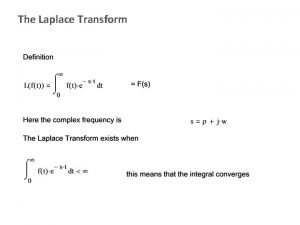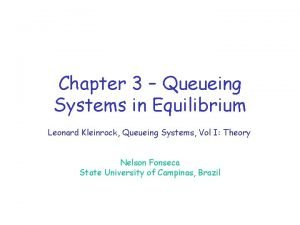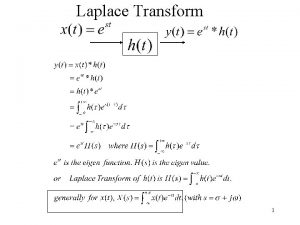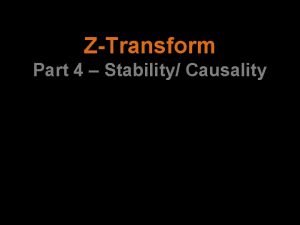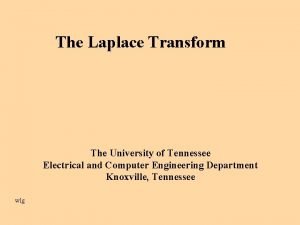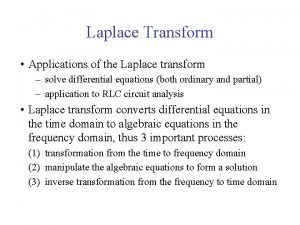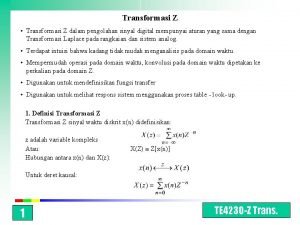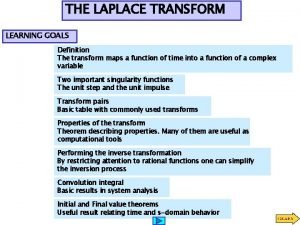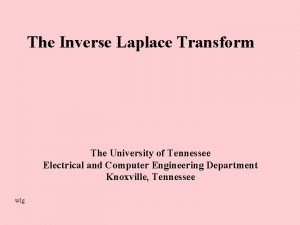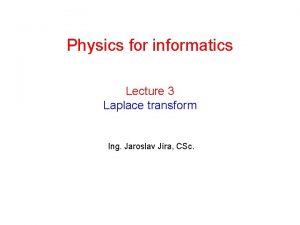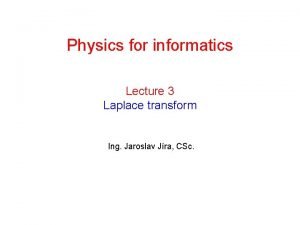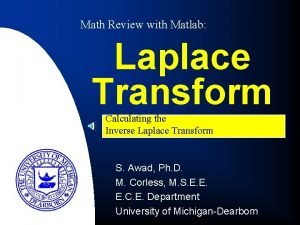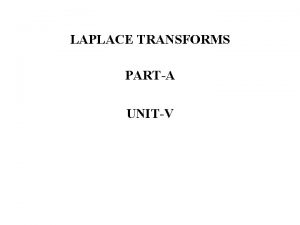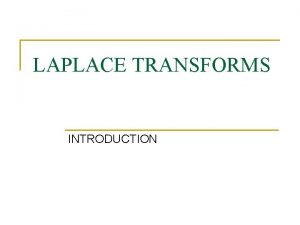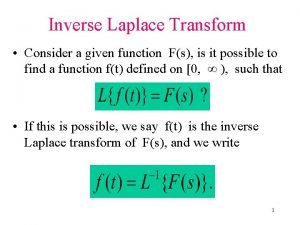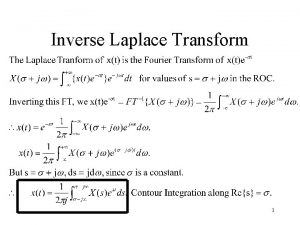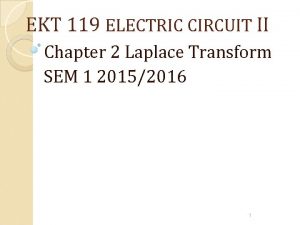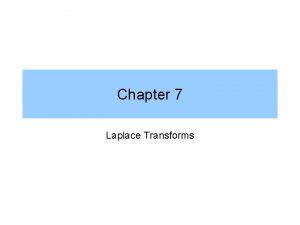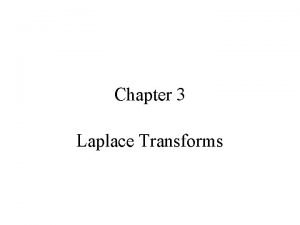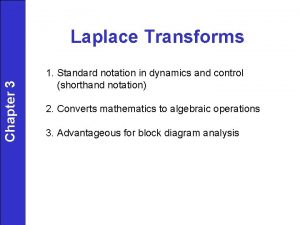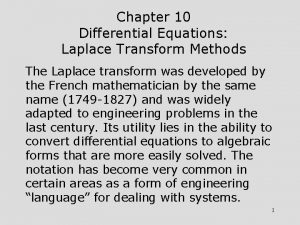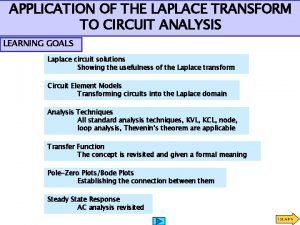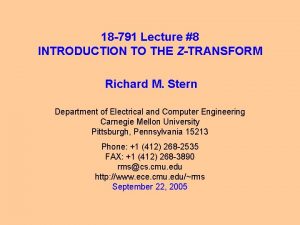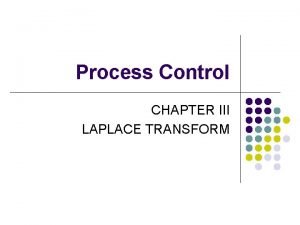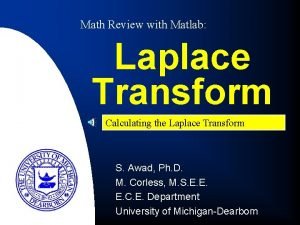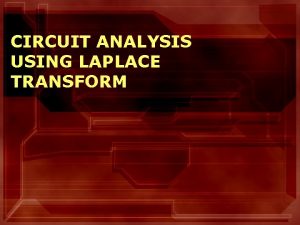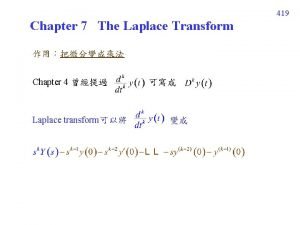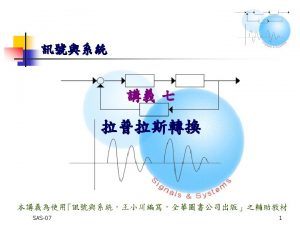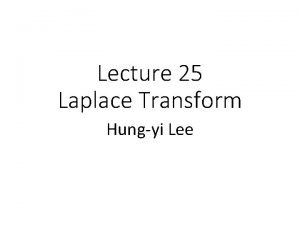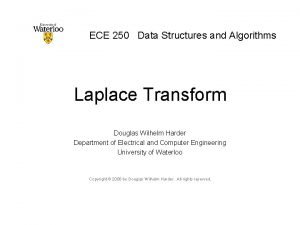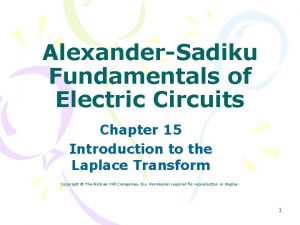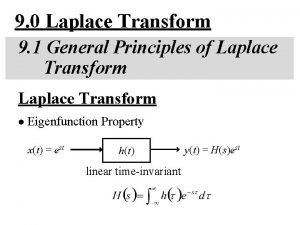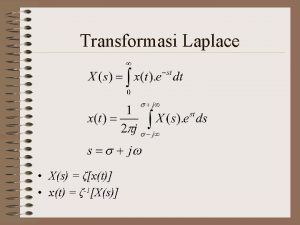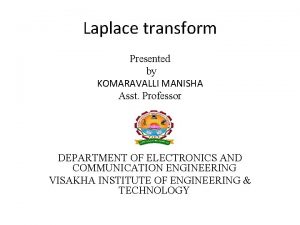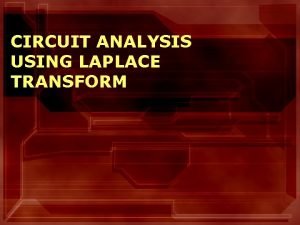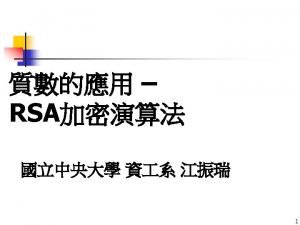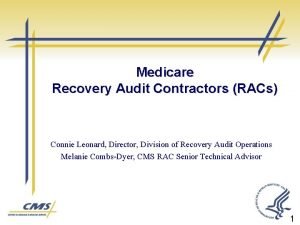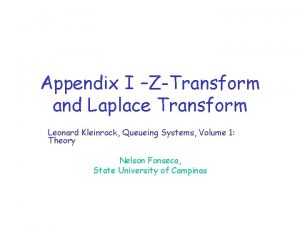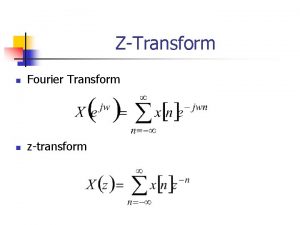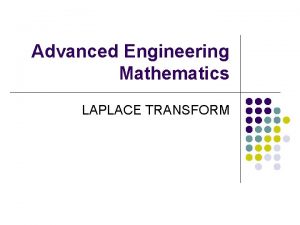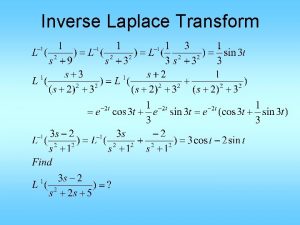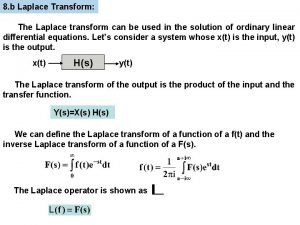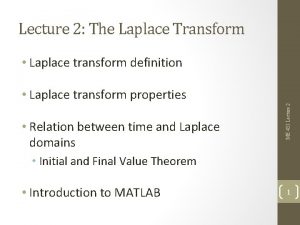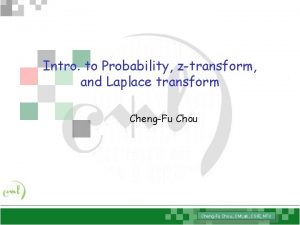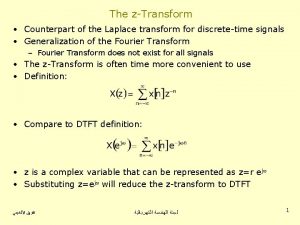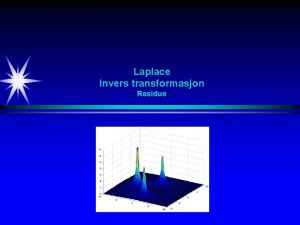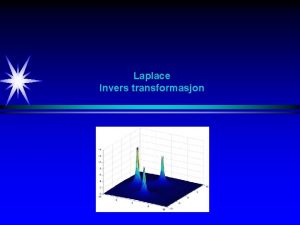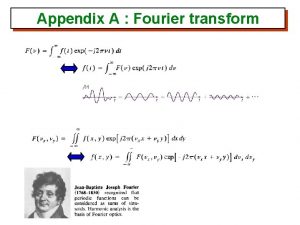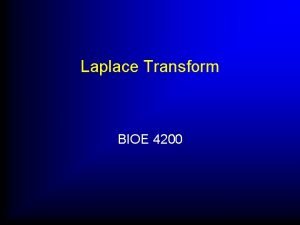Appendix I ZTransform and Laplace Transform Leonard Kleinrock




















































- Slides: 52

Appendix I –Z-Transform and Laplace Transform Leonard Kleinrock, Queueing Systems, Volume 1: Theory Nelson Fonseca, State University of Campinas

I. 1 Why Transforms? • They greatly simplify the calculations • They arise naturally in the formulation and the solution of systems problems • Oftentimes they are the only tools we have available for proceeding with the solution at all

f SYSTEM g • System: a mapping between the input function and the output function. The system operates on function f to produce the function g. • The f and g functions depend upon an independent time parameter t: f(t) and g(t)

• Linear time-invariant systems: transforms do appear naturally • Linear system: where a and b are time independent variables • Time-invariant systems • Which functions of time f(t) may pass through our linear time-invariant systems with no change in form? where H is some scalar multiplier

• These functions are the “eingenfunctions” or “characteristic functions” • Answer: Complex exponential function where s is a complex variable • From the time-invariance property we must have:

• H is independent of t but may certainly be a function of s • Wish: be able to decompose the function f(t) into a sum (or integral) of complex exponentials, each of which contributes to the overall output g(t) through a computation of the form given: The overall output may be found by summing (integrating) these individual components of the output

• The Transform Method : decompose our input into sums of exponentials, compute the response to each from these exponentials, and then reconstitute the output from sums of exponentials • Linear time-invariant systems: constantcoefficient linear differential equations

Discrete-Time Systems • Discrete Time Systems: the function f is defined in some points, multiples of a unit t where n = …, -2, -1, 0, 1, 2, … • Notation: • For discrete-time systems we still have:

• Eingenfunctions • • • H how much of a given complex exponential we get out of our linear system when we insert a unit amount of that exponential at the input system (or transfer) function

• Definition: Kronecker delta function (or unit function) •

Let us make the change of variable for the sum on the right-hand side of expression, giving:


I. 2 The Z-Transform

• The disk |Z| < 1 represents a range of analyticity for F(Z) is the sum of is finite


Z-Transform properties



• Inspection method to find the sequence given the Z-Transform – Look for terms that are easily invertible

• It is necessary to divide the denominator into the numerator until the remainder is lower degree than the denominator • Example:



I. 3 The Laplace Transform • Continuous time • F(t) = 0, t < 0 • Transform a time function in another variable and then “untransform” • For the reasons of invariance of the solution, the “tag” is • Complex variable

This Laplace transform will exist so long as f(t) grows no faster than an exponential

• Region of analyticity Re (s) >= 0 • The properties for the Z-transform when Z=1 will correspond to properties for the Laplace transform when s=0

• A special case of our one sided exponential function when A=1, a=0 • Definition: • Function with area=1 and value >0, only with t=0

8 pulse gets taller and • As a increases, we note that the narrower. The impulse function is defined when a a=8 4 a=1 2 a=2 -1/4 1 -1/8 -1/16 0 1/16 A 0 a 1/8 1/4 1/2 t

• The “derivative” of the unit step function must therefore be a unit impulse function • Sifting property • Derivative of the unit impulse: unit doublet • Function is 0 everywhere, except in the vicinity of the origin it runs off to infinity just to the left of the origin and off to - infinity just to the right of the origin, and, in addition, has a total area equal to zero

• We can define • Inverse process of the integral

• Transform of the convolution Convolution definition:




The inspection method for inverse transforms




I. 4 Use of transforms in the solution of difference and differential equations • Solution of a differential equation Let us consider:

• Homogeneous and a particular solution: • Homogeneous solution: • General form of solution: where A and a are yet to be determined If we substitute the general solution into the equation, we find:

• Nth-order polynomial has N solutions: • Associated with each such solution is an which will be determined from the initial conditions (N conditions) • By canceling the common term then the solution is: • Solution: resolution of polynomial equation

• If there are no multiple roots, the homogenious solution is: • In case of non-distinct roots, the k equal roots will contribute to the following form: • Particular solution: guess from the form of Example:

• Second-order equation: exist for n=2, 3, 4, …There are two initial conditions, • Homogeneous solution: • Particular solution: must be guessed from

• Using the initial conditions, we find that

• Method of Z-transform for solving difference equations – Our approach begins by defining the Z-transform – Then we may apply our inversion techniques – Put G(Z) in evidence and the function is calculated by the inspection method Equation:



• Solution of constant-coefficient linear differential equations • Solution = homogeneous + particular • The form of the homogeneous solution will be:




• Solution of differential equations by the Laplace transform

 Leonard kleinrock
Leonard kleinrock Laplace transform formula list
Laplace transform formula list Kleinrock queueing systems
Kleinrock queueing systems Z transform table
Z transform table Z transform of exponential function
Z transform of exponential function Relation between laplace and fourier transform
Relation between laplace and fourier transform Causality and stability in z-transform
Causality and stability in z-transform Initial and final value theorem
Initial and final value theorem Derivation of laplace transform
Derivation of laplace transform Formula of laplace transform
Formula of laplace transform Pengertian transformasi z
Pengertian transformasi z Laplace transform of 1
Laplace transform of 1 Inverse laplace
Inverse laplace Scott surgent asu
Scott surgent asu Laplace transform
Laplace transform Laplace transform shift
Laplace transform shift Matlab partial fraction expansion
Matlab partial fraction expansion Laplace
Laplace Final value problem
Final value problem Laplace of sint
Laplace of sint Inverse laplace transform of trigonometric functions
Inverse laplace transform of trigonometric functions Inverse laplace transform contour integration
Inverse laplace transform contour integration Laplace transform symbol
Laplace transform symbol Bilateral laplace transform table
Bilateral laplace transform table Laplace transform of differential equation
Laplace transform of differential equation Laplace transform notation
Laplace transform notation Unit step function examples
Unit step function examples Laplace circuit analysis
Laplace circuit analysis Z transform vs laplace
Z transform vs laplace Chapter
Chapter Laplace transformation matlab
Laplace transformation matlab S-domain circuit
S-domain circuit Laplace transform
Laplace transform S shifting theorem
S shifting theorem Final value theorem transfer function
Final value theorem transfer function Laplace transform derivative
Laplace transform derivative Unilateral laplace transform
Unilateral laplace transform Find the laplace transform of 15/2
Find the laplace transform of 15/2 Laplace transform
Laplace transform Sifat-sifat transformasi laplace
Sifat-sifat transformasi laplace Laplace transform piecewise
Laplace transform piecewise Laplace transform of inductor
Laplace transform of inductor Ron rivest, adi shamir, and leonard adleman
Ron rivest, adi shamir, and leonard adleman Léonard de vinci parachute
Léonard de vinci parachute Charters brushing technique
Charters brushing technique The pedestrian main character
The pedestrian main character Leonard sacks fda
Leonard sacks fda Tritone maria west side story
Tritone maria west side story What is the word according to leonard bloomfield?
What is the word according to leonard bloomfield? Connie leonard cms
Connie leonard cms Vinci
Vinci Anghiani
Anghiani Leonard pearlin theory of psychological distress
Leonard pearlin theory of psychological distress

